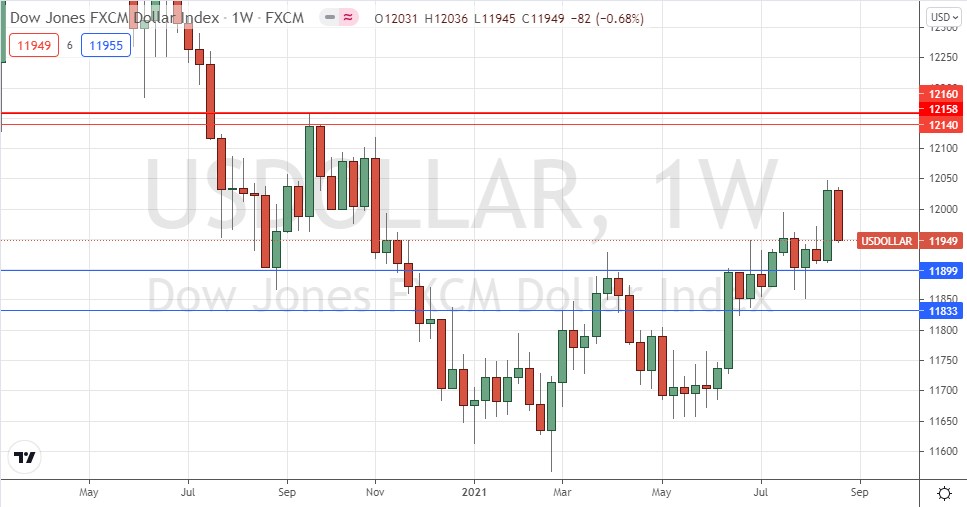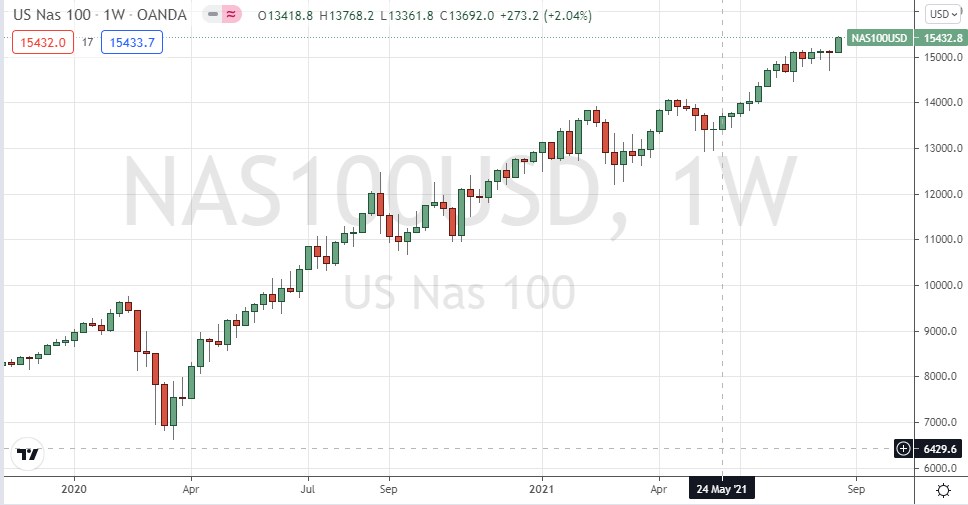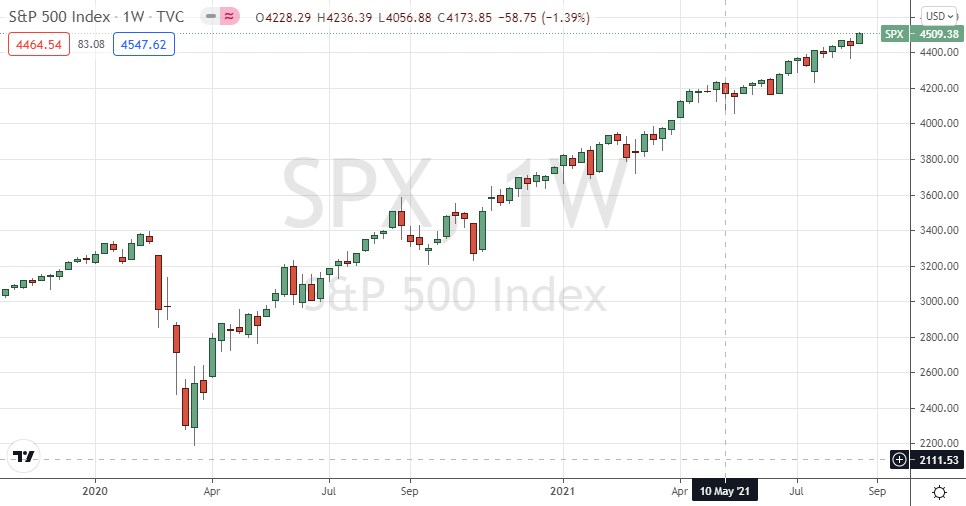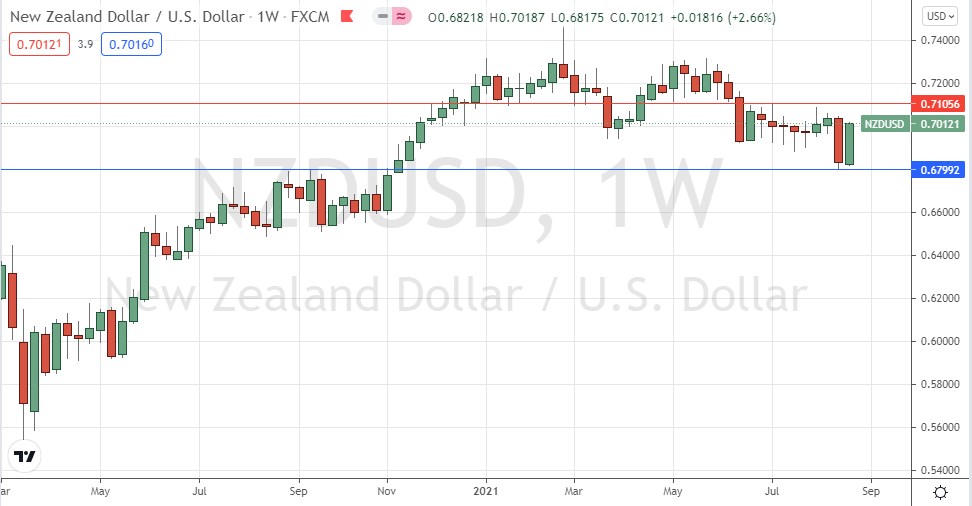The difference between success and failure in Forex trading is very likely to depend mostly upon which currency pairs you choose to trade each week and in which direction, and not on the exact trading methods you might use to determine trade entries and exits.
When starting the trading week, it is a good idea to look at the big picture of what is developing in the market as a whole and how such developments and affected by macro fundamentals and market sentiment.
There are several strong valid trends in the market right now, so it is a great time to be trading to take advantage of that.
Big Picture 29th August 2021
Last week’s Forex market mostly moved counter-trend but with only moderate strength. The New Zealand and Australian dollars were strong, while the U.S. dollar was weak.
I wrote in my previous piece last week that the best trade was likely to be long of the NASDAQ 100 Index following a daily (New York) close above 15198 and short of the AUD/USD currency pair. The NASDAQ 100 Index produced a gain after closing above 15198 of 0.65%, while the AUD/USD currency pair unfortunately rose by 2.42% last week, producing an averaged loss of 0.89%.
Fundamental Analysis & Market Sentiment
The headline takeaway from last week was strong counter-trend movement made by the U.S. dollar and antipodean currencies. The rest of the Forex market was relatively quiet. The economic impact of the resurgent coronavirus globally driven by the delta variant also remains a concern to risk appetite as it causes problems with supply chains. The major news event driving the Forex market was the indication by Jerome Powell at the Jackson Hole Symposium that QE tapering would likely begin at some point before the start of 2022, which was no surprise to anyone. U.S. preliminary GDP came in almost exactly as had been expected by the market consensus.
It is worth noting that U.S. stocks represented by the S&P 500 and NASDAQ 100 broke to new record high prices.
Next week will be dominated by U.S. non-farm payrolls and Australian GDP data. It is likely that the Forex market will be more active next week as the summer months end and September begins.
Last week saw the global number of confirmed new coronavirus cases fall for the first week after rising for more than two months, although deaths, which of course lag new cases, rose again. The more highly infectious Delta (Indian) variant has had a major impact on global numbers. Approximately 33.2% of the global population has now received at least one vaccination.
It seems to be becoming clear that due to the widespread Delta variant, which studies are beginning to show may be as easily transmissible as chickenpox, the only way to stop natural spread of the disease by “herd immunity” would be for more than 95% of an entire population to be fully vaccinated. There are also increasing indications that the effectiveness of vaccines wanes notably after approximately five months has elapsed from the last administration. These factors make even a local eradication of the coronavirus extremely difficult to achieve. Some nations have already begun to administer third “booster” shots to ensure greater protection for the older population.
The strongest growth in new confirmed coronavirus cases right now is happening in Albania, Armenia, Australia, Azerbaijan, Barbados, Belarus, Bosnia, Bulgaria, Canada, Costa Rica, Dominica, Ethiopia, Germany, Greece, Israel, Japan, Malaysia, Mongolia, Montenegro, New Zealand, Norway, Philippines, Serbia, Slovenia, Somalia, the U.S., the U.K., and Vietnam.
Technical Analysis
U.S. Dollar Index
The weekly price chart below shows the U.S. Dollar Index printed a bearish inside candlestick last week. However, the price is still well above the prices of recent weeks and well above levels from 3 and 6 months ago, which shows that the long-term bullish trend in the greenback is still valid. This suggests that trades long of the USD against other currencies are still most likely to be appropriate over this coming week, provided that the market begins to turn – do not try to catch a falling knife before the turn.
NASDAQ 100 Index
The NASDAQ 100 Index printed a firm bullish candlestick which ended the week just a fraction below its record high price. Since the coronavirus crash of 2020, this major U.S. equity index has more than doubled in value, which is an excellent return over barely seventeen months. The NASDAQ 100 Index remains a buy.
S&P 500 Index
The S&P 500 Index printed a firm bullish candlestick which ended the week just a fraction below its record high price. Since the coronavirus crash of 2020, this benchmark U.S. equity index has more than doubled in value, which is an excellent return over barely seventeen months. The S&P 500 Index is a buy.
NZD/USD
The NZD/USD currency pair rose very strongly last week, rebounding from a long-term low price. This currency pair is showing the highest volatility in the Forex market right now. Although technically this is certainly a counter-trend movement, short-term Forex traders may be interested in finding short-term trends on lower timeframes in this currency pair to exploit. There is key support at 0.6800 and key resistance at about 0.7100.
Bottom Line
I see the best opportunity in the financial markets this week as being long of the NASDAQ 100 and S&P 500 indices.





